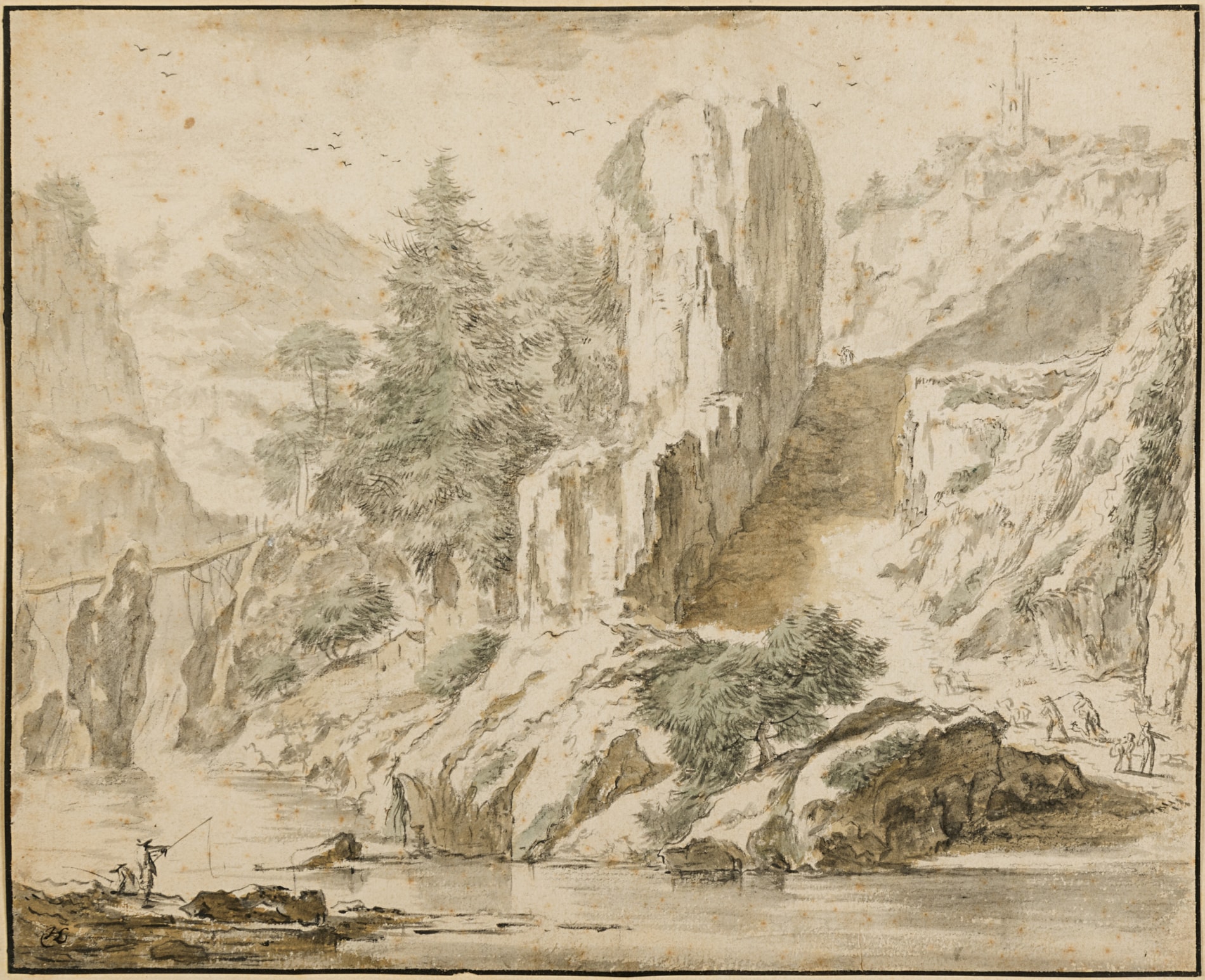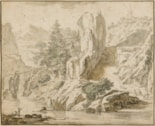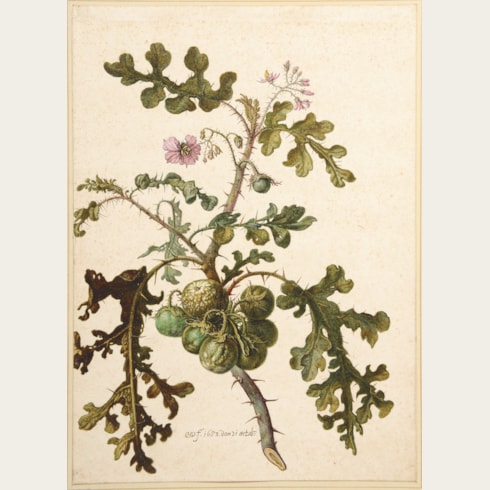Herman SAFTLEVEN
(Rotterdam 1609 - Utrecht 1685)
A Mountainous River Landscape with Fishermen
Sold
Pen and brush and grey ink, with green and brown washes, over an underdrawing in black chalk, with framing lines in brown ink.
Signed with the artist’s monogram HSL at the lower left.
264 x 325 mm. (10 3/8 x 12 3/4 in.)
Signed with the artist’s monogram HSL at the lower left.
264 x 325 mm. (10 3/8 x 12 3/4 in.)
The present sheet may be dated to the later part of Herman Saftleven’s career, from the late 1640s onwards, when he was, as Carolyn LOgan has noted, ‘painting panoramic and Rhenish river landscapes enlivened with anecdotal details that he based on sketches he made during travels along the Moselle and through the Rhineland.’ Many of these large, sometimes imaginary Rhineland views may be counted among the artist’s most appealing drawings.
Stylistically comparable works by Saftleven include a Landscape with Castle on a Steep Rock in the Pushkin Museum in Moscow, a Mountain Landscape of c.1650 in the Teylers Museum in Haarlem, and a drawing of An Extensive Rocky River Landscape, signed and dated 1648, formerly in the John Appleby collection and sold at auction in 2010. Also comparable is a Rocky Landscape with Figures, dated 1648, in the British Museum, and a Rocky Bay with Fishermen, dated 1650, in a private collection.
Stylistically comparable works by Saftleven include a Landscape with Castle on a Steep Rock in the Pushkin Museum in Moscow, a Mountain Landscape of c.1650 in the Teylers Museum in Haarlem, and a drawing of An Extensive Rocky River Landscape, signed and dated 1648, formerly in the John Appleby collection and sold at auction in 2010. Also comparable is a Rocky Landscape with Figures, dated 1648, in the British Museum, and a Rocky Bay with Fishermen, dated 1650, in a private collection.
Herman Saftleven was the younger brother of Cornelis Saftleven and studied with him, probably under their father, the obscure painter Herman Saftleven the Elder, in Rotterdam. Although the two brothers briefly worked together in the 1630s, notably at the palace of Huis Honselaarsdijk in 1635, the younger Saftleven made his career in Utrecht. He had settled there by 1632, becoming a citizen of the city some twenty-five years later. (He also served as an officer of the city’s artist’s guild between 1655 and 1667.) Active mainly as a landscape painter, Saftleven painted a variety of Italianate landscapes, Rhineland scenes and imaginary river views, as well as topographical views of Utrecht and the surrounding area, wooded and mountain vistas and farmhouse genre scenes. While his early manner as a topographical artist is indebted to the example of such artists as Jan van Goyen (with whom he may have studied) and Pieter Molijn, by the 1640s he was working in a more Italianate manner, inspired by the example of Jan Both and Cornelis van Poelenburch. He had achieved his mature style by around 1650, producing expansive landscape paintings and drawings inspired by his travels along the Rhine and Moselle rivers and their tributaries.
A prolific artist, Saftleven produced around three hundred paintings and some 1,400 drawings, mostly finished landscapes, together with some forty etchings. Many of his drawings are signed and dated, large-scale sheets intended as independent works for collectors, as well as for such publications as the Amsterdam collector Laurens van der Hem’s fifty-volume Atlas Maior. Writing around 1660, the Dutch poet and playwright Joost van der Vondel, who was a friend of Saftleven’s, noted in verse that, whomsoever owned an album of the artist’s landscape drawings, could ‘Catch some air, if he wants, / While staying home, safe and quiet: / He can quietly travel up the Rhine, / from Utrecht, and its Cathedral; / Between banks and streams, / Between vineyards, woods, and trees, / To amuse himself, / Canals, cities and farmland, / Herds, cattle, villages and hamlets, / Fields, and townships, and fences, / To behold Springs and waterfalls, / In his room, when he turns / To these works on paper, / So full of life, so full of elegance.’ In the last few years of his career, between 1680 and 1684, Saftleven drew nearly a hundred botanical drawings of flowers and plants, in watercolour and gouache, that were commissioned from him by the amateur horticulturalist and botanist Agnes (Agneta) Block, although less than thirty of these works survive today. Significant groups of landscape drawings by Herman Saftleven are in the Rijksmuseum in Amsterdam, the Kupferstichkabinett in Berlin, the British Museum in London and the Albertina in Vienna.
A prolific artist, Saftleven produced around three hundred paintings and some 1,400 drawings, mostly finished landscapes, together with some forty etchings. Many of his drawings are signed and dated, large-scale sheets intended as independent works for collectors, as well as for such publications as the Amsterdam collector Laurens van der Hem’s fifty-volume Atlas Maior. Writing around 1660, the Dutch poet and playwright Joost van der Vondel, who was a friend of Saftleven’s, noted in verse that, whomsoever owned an album of the artist’s landscape drawings, could ‘Catch some air, if he wants, / While staying home, safe and quiet: / He can quietly travel up the Rhine, / from Utrecht, and its Cathedral; / Between banks and streams, / Between vineyards, woods, and trees, / To amuse himself, / Canals, cities and farmland, / Herds, cattle, villages and hamlets, / Fields, and townships, and fences, / To behold Springs and waterfalls, / In his room, when he turns / To these works on paper, / So full of life, so full of elegance.’ In the last few years of his career, between 1680 and 1684, Saftleven drew nearly a hundred botanical drawings of flowers and plants, in watercolour and gouache, that were commissioned from him by the amateur horticulturalist and botanist Agnes (Agneta) Block, although less than thirty of these works survive today. Significant groups of landscape drawings by Herman Saftleven are in the Rijksmuseum in Amsterdam, the Kupferstichkabinett in Berlin, the British Museum in London and the Albertina in Vienna.






